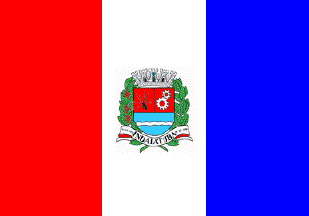 image by Ivan Sache, 1 January 2012
image by Ivan Sache, 1 January 2012Source: http://www.indaiatuba.sp.gov.br/cidade/brasao/

Last modified: 2013-01-21 by ian macdonald
Keywords: sao paulo | indaiatuba |
Links: FOTW homepage |
search |
disclaimer and copyright |
write us |
mirrors
 image by Ivan Sache, 1 January 2012
image by Ivan Sache, 1 January 2012
Source:
http://www.indaiatuba.sp.gov.br/cidade/brasao/
It is a vertical tricolor of red-white-blue with the municipal coat of arms
in the center of the white field.
Valentin Poposki, 26 February 2007
Indaiatuba was in the 18th century a main area of sugarcane
cultivation. The first horizontal mill equipped with wooden cylinders
was set up in Indaiatuba. Table grape is today the main crop in the
municipality, Indaiatuba being one of the main producers in São Paulo
State, with 7 millions grapevines producing each year 4 millions boxes
of grapes.
Indaiatuba, however, is mostly known as one of the main Brazilian
industrial towns. Industrialization started in the 1920s. Between 1930
and 1945, the town specialized in wood processing industry, being
nation-wide famous for the production of umbrella shafts. The textile
industry started in the town in 1945, joined in 1960 by mechanics
industry and steelmaking. The establishment in 1973 of the Industrial
District boosted the development of the town; the number of industries
registered in the municipality increased from 37 in 1970 to 75 in 1975
and 422 in 1980.
http://www.indaiatuba.sp.gov.br - Municipal website
Photos of the flag:
http://www.flickr.com/photos/imobiliaria_igp/4372881520
http://domjose.wordpress.com/2008/11/19/19-de-novembro-dia-da-bandeira
http://www.itu.com.br/conteudo/detalhe.asp?utm_source=rss&utm_medium=rss&utm_campaign=rss&cod_conteudo=32626
http://www.indaiatuba.sp.gov.br/governo/imprensa/noticias/13841
The coat of arms of Indaiatuba, prescribed by Municipal Law No. 930 of 17 October 1966, "obeys the strict principles of heraldry".
The shield is rounded-off, in the peninsular Portuguese style,
recalling the Lusitanian past of Brazil.
The two [upper] fields gules (red) are a symbol of liberty,
intrepidity and pugnacity. The third field, azure (blue), is a symbol
of loyalty, glory, serenity and zeal.
In the first quarter, the indaiá* is a straightforward reference to
the name of the town, used since its early times. In the second
quarter, the two joined gear wheels represent the industrial power of
the town, which allowed its progress and constant evolution. In the
third quarter, the fess wavy argent represents river Jundiaí, which is
the base of the hydrographic system in the municipality.
The mural crown is the dedicated symbol of a municipality. The
escutcheon azure charged with a fleur-de-lis argent surmounting the
central port of the crown is the symbol of the patron saint of the
municipality, Our Lady of Candelaria.
The dexter supporter, a branch of coffee, is the symbol of the work of
all Paulistas who set up the coffee plantations, contributing to the
increase of Brazil and to the consolidation of its international fame.
The sinister supporter, a branch of laurel, is a permanent reference
to the glory of Indaiatuba people, who did their best for the increase
of the town, and, therefore, of São Paulo and of Brazil.
http://www.indaiatuba.sp.gov.br/cidade/brasao - Municipal website
* indaiá [Attalea dubia (Mart.) Burret; synonym, Attalea indaya Drude] is a Brazilian palm best known as the Bacuaçu palm. http://commons.wikimedia.org/wiki/File:Palmeira_de_indaiá_REFON_.jpg - Photo http://coldb.mnhn.fr/ScientificName/attalea/dubia - Herbarium specimens at the National Museum of Natural History, Paris
Ivan Sache, 1 January 2013